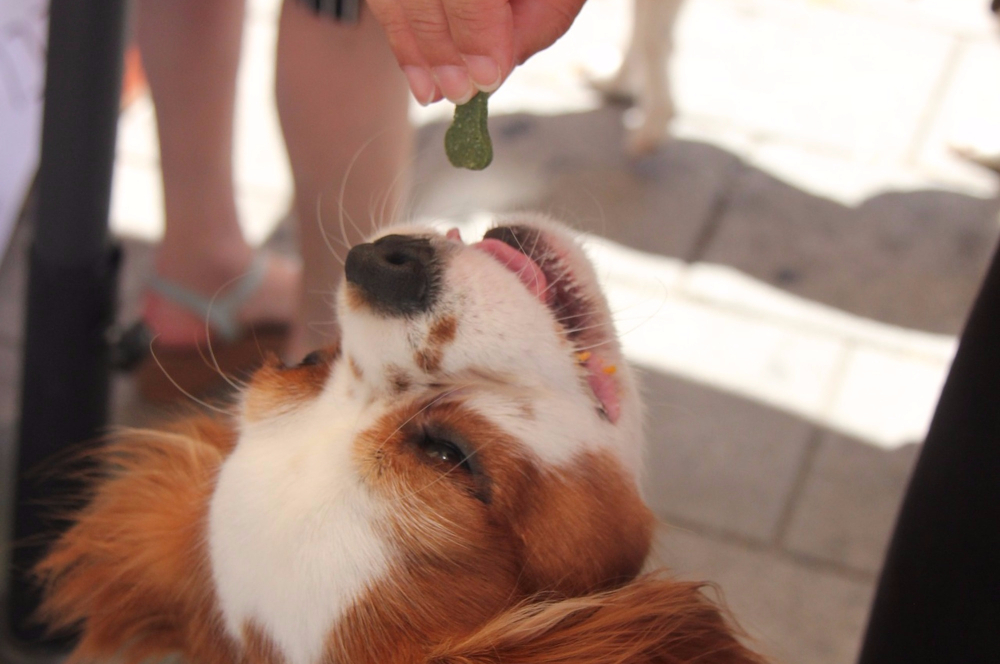Puppies love treats, and you love your puppy. Whatever makes them happy makes you happy.
It’s no surprise that many of us are tempted to give puppies treats whenever they beg for one. After all, so many treats offer additional benefits like teeth cleaning and vitamins.
But while treats are a delicious part of your best friend’s balanced diet, the “too much of a good thing” rule also applies.
That’s why dog owners are encouraged to follow what’s called the 10 percent rule.
What Is the 10 Percent Rule?
The ten percent rule is simple.
Treats shouldn’t make up more than 10 percent of your dog’s daily caloric intake.
Yes, that means counting your dog’s calories. When treats remain within the 10 percent guideline, you don’t need to worry about whether those treats are healthy treats or just for fun.
As long as your pooch is enjoying an otherwise healthy and balanced diet and doesn’t have any additional health issues, there’s no reason not to ply them with these treats – within reason.
Is Your Dog Eating a Balanced Diet?
If you’re buying veterinarian recommended dog food, then it’s likely your pet is eating a balanced diet. Though, that assumes you are feeding them the correct amount and not sneaking him table scraps and other treats on top of their daily dinner.
How do you know your dog is eating a balanced diet? If you buy dog food that is labeled as “complete and balanced”, then the food manufacturers have followed specific dietary guidelines.
Dog food is regulated by the Association of American Feed Control Officials (AAFCO). The AFFCO creates rules to ensure that pet food companies don’t run around saying their product is healthy when it really isn’t. These laws ensure there is a baseline nutrient guide based on what your dog really needs. Without meeting these laws, a pet food can’t be labeled as “complete and balanced.”
What’s in Your Pet’s Food?
If you’re buying a “complete and balanced” dog food, then the recipe will include these macronutrients:
- Carbohydrates
- Proteins
- Fats
It will also include vitamins, minerals, and water.
The number of carbohydrates included in your dog’s food may range from 30 to 70 percent depending on the brand and the type of food required. In many cases, the carbs will come from cereal grains like barley, corn, oats, rice, or wheat. These are easy for the average dog to digest and they help hold the food together.
Some of the carbohydrates added to dog food also include fiber. In many cases, beet pulp is added to food to add carbs and to help their digestive systems process food at a healthy pace. It also helps keep your dog “regular”. Beet pulp is like Metamucil for dogs.
About 18 to 25 percent of the dog’s food comes from sources of protein. Beef, chicken, eggs, turkey, lamb, and fish are used to add protein to dog food.
Finally, there’s fat. Fats help provide energy and are good for your dog’s skin and coat. But they’re also important for adding flavor to food. About 10 to 15 percent of your dog’s food will be made up of fat that comes from oils or from animal fat.
These are the main building blocks of dog food – without these measurements, a dog food will be marketed as being healthy or delicious, but it won’t have the “complete and balanced” label you’re looking for.
How Dog Treats Impact a Balanced Diet
Get 3rd bag FREE with purchase of any 2 bags of dog treats! pic.twitter.com/cLuQD18Am5
— Suburban Mutt (@SuburbanMutt) January 15, 2018
The average adult dog needs a diet featuring up to 70 percent carbs, 25 percent protein, and 15 percent fat. They should be getting most of that from their dog food. Treats can be used to supplement their diet, but they should never be used as a meal replacement.
Here’s why:
Dog treats aren’t regulated the way dog food is. There’s no minimum standard for dog treat nutrition. That means your dog treats likely aren’t nutritionally balanced. Eating too many of them could throw off the balance in your dog’s diet.
For example, if your dog loves a treat that’s high in fat and he eats more than his daily allowance, he could skew his fat intake from 15 percent of his diet to 20 or even 25 percent of his diet. While fat is a healthy and necessary part of a dog’s diet, too much fat over a long period of time ultimately results in a fat dog. And overweight dogs suffer many of the same health problems that people do.
As you can see, it’s not hard for too many fats or carbs or protein to throw off the balanced diet you feed your dog. However, by following the 10 percent rule, you don’t need to worry about the macronutrient count in dog treats.
How to Find Healthy Pet Treats
The principles of healthy eating don’t differ much between humans and their pets.
If you, as a human, eat a balanced diet most of the time, then there’s no reason you can’t indulge in in a packet of Oreos every once in a while. It won’t affect your long-term health. However, few can deny that enjoying healthy treats is always a better option when you’re looking for something special.
The same is true for dogs. You don’t need to worry about finding them kale-based treats if they are otherwise healthy. But finding healthy treats never hurts. There’s another clear parallel between human and dog treats: it can be hard to find treats that are healthy because everyone has a different definition of what ‘healthy’ is and what isn’t. And because dog treats manufacturers aren’t regulated like dog food, some won’t know what’s in their products or even how many calories are found in a single serving.
This is why you need to be extra vigilant when searching for dog treats. When looking for healthy dog treats, start by looking at the company.
Here are a few things to ask a dog treat company:
- What are your quality standards?
- Do you have a full-time veterinary nutritionist on staff?
- What is the full nutrient profile of the product?
If the company can’t answer one or more of these questions, then it’s a good idea to stay away. Even if the dog treats look good and may be healthy, you can’t ensure the same quality between batches.
Dog Treat Safety
Searching for high-quality dog treats isn’t just about supporting your pet’s diet. Finding high-quality treats protects their overall health.
Because dog treats aren’t regulated, some dog treat manufacturers use suspect ingredients in dog treats as a way of cutting costs or improving productivity.
The result has been a spate of dog illnesses and even deaths linked to the consumption of treats.
Jerky treats are the most suspect. In some cases, manufacturers sources their meat ingredients from places like China, where food standards are lower than they are in the United States.
The problem is not a one-off issue featuring a bad batch. At the end of 2015, around 5,2000 complaints had been sent to the FDA related to canine illness associated with jerky treats. These reports also included 1,140 deaths of dogs across the country.
According to the FDA, most of the reports are made about products that include chicken jerky. Although it is impossible to say that every report of illness was the result of eating these treats, the sheer number of reports combined with the common link suggests a reason for concern.
The FDA has tested some of the products reported and analyses have produced findings that include:
- Salmonella B and other pathogenic bacteria
- Arsenic, lead, and other elements
- Pesticides
- Antibiotics
- Mold and toxins from mold
- Radioactivity
- Rodenticides
- Other listed poisonous chemicals and compounds
Treats Linked to FLS
The FDA has found that the most common issue related to these pet treats is called Fanconi-Like Syndrome (FLS). When a dog has FLS, the dog develops a kind of kidney disease typically only found in dogs who have a hereditary kidney disease.
FLS results in damage to the proximal tubule of the kidney. Without the proximal tubule, the kidneys aren’t able to send healthy nutrients into the bloodstream. Instead, they are sent away with waste and escape into the dog’s urine.
A dog with FLS will usually begin to drink more than usual and urinate frequently. They may also lose interest in eating and begin to experience general lethargy.
Are Homemade Treats Healthier?
Homemade dog treats for my furbaby. They are all natural and she absolutely loves them! Always baking something great!!! #homemade #baking #dogsoftwitter pic.twitter.com/zQoMUzfukq
— Christina Werner (@OfficialCWerner) January 21, 2018
For some, the solution is to try homemade treats. Either from their own home or from a pet bakery. If your treats at home are made from pet nutritionist-approved recipes, they could be healthier.
Homemade treats are usually made from few ingredients and don’t take a lot of hassle, so you might want to look up recipes that you feel would appeal to your pup and that come from trusted sources. Popular recipes involve combining usually four or five ingredients to make dough and then baking the treats in the oven for 30-40 minutes. Piece of cake.
A common ingredient in homemade dog treats is peanut butter – as we all know, most dogs are fascinated by it. Plus, peanut butter is packed with healthy fats, so it can be great for both you and your dog as long as you two only eat in moderation.
To make sure the treats are even healthier, use fresh, organic ingredients whenever possible. Skim milk, whole wheat flour, natural peanut butter, organic eggs, and so on. If your dog is sensitive to wheat, you can substitute the flour with oats. The entire thing will be even more delicious. There are countless ingredient-combos you can try, so invite your furry friend in the kitchen to keep you company while you experiment with various recipes.
If you take the pet bakery route, don’t forget to ask the same questions that you would of a pet treat manufacturer. In some cases, a baker won’t have any better idea of pet nutrition than a large manufacturer will. So, be sure to ask about caloric content and nutritional profiles, quality control, and the presence of a pet nutritionist.
Follow the 10 Percent Rule
A healthy dog is a happy dog, and you’re a big part of your dog’s health.
By following the 10 percent rule to help keep your dog’s diet “complete and balanced”, you’ll ensure they get their daily dose of treats without impacting their health.
All dogs (and humans) deserve a treat once in a while, but it’s important to ensure their treats don’t do more harm than good.
Have you found a healthy (and tasty) dog treat? Share your stories in the comments below.






